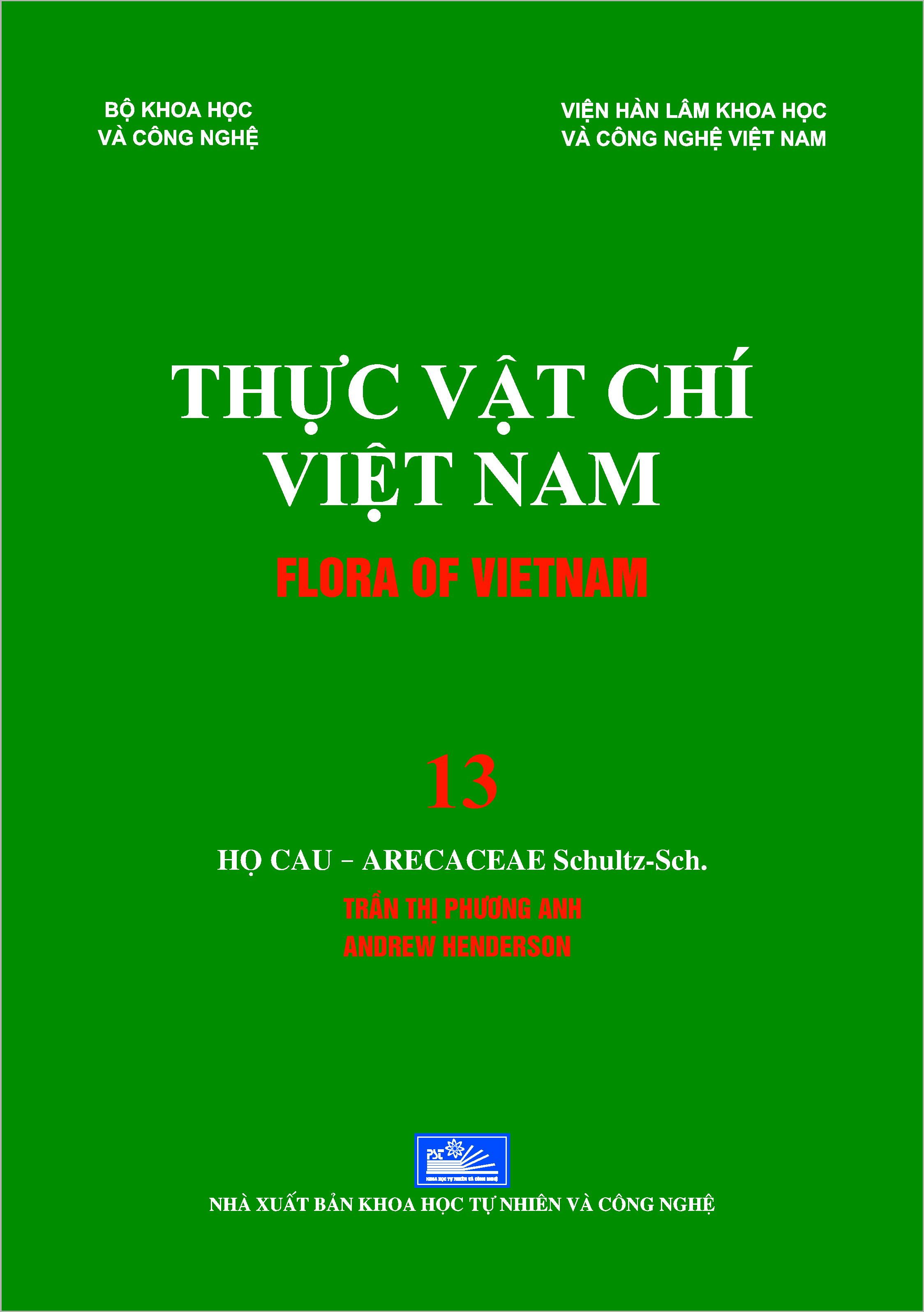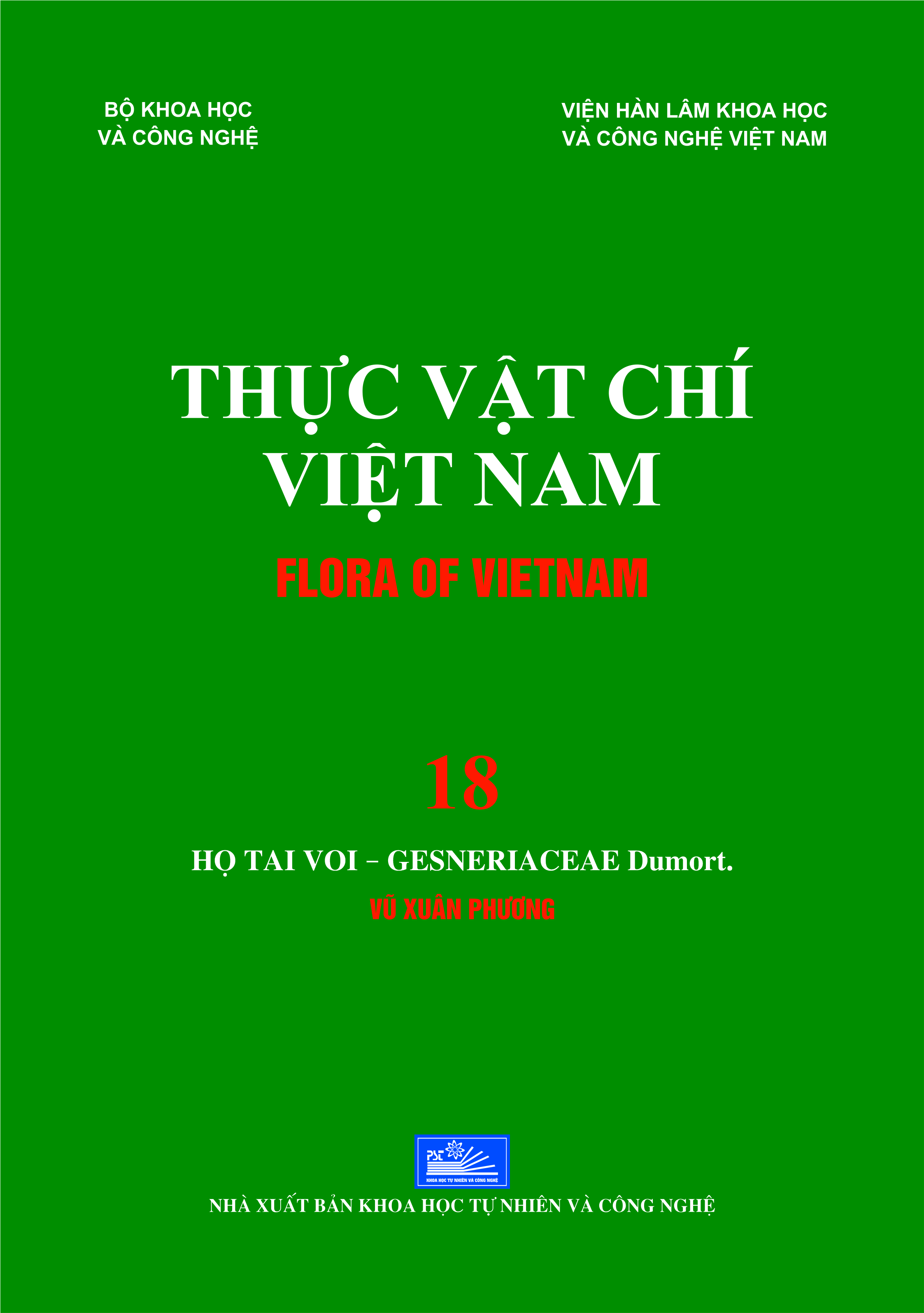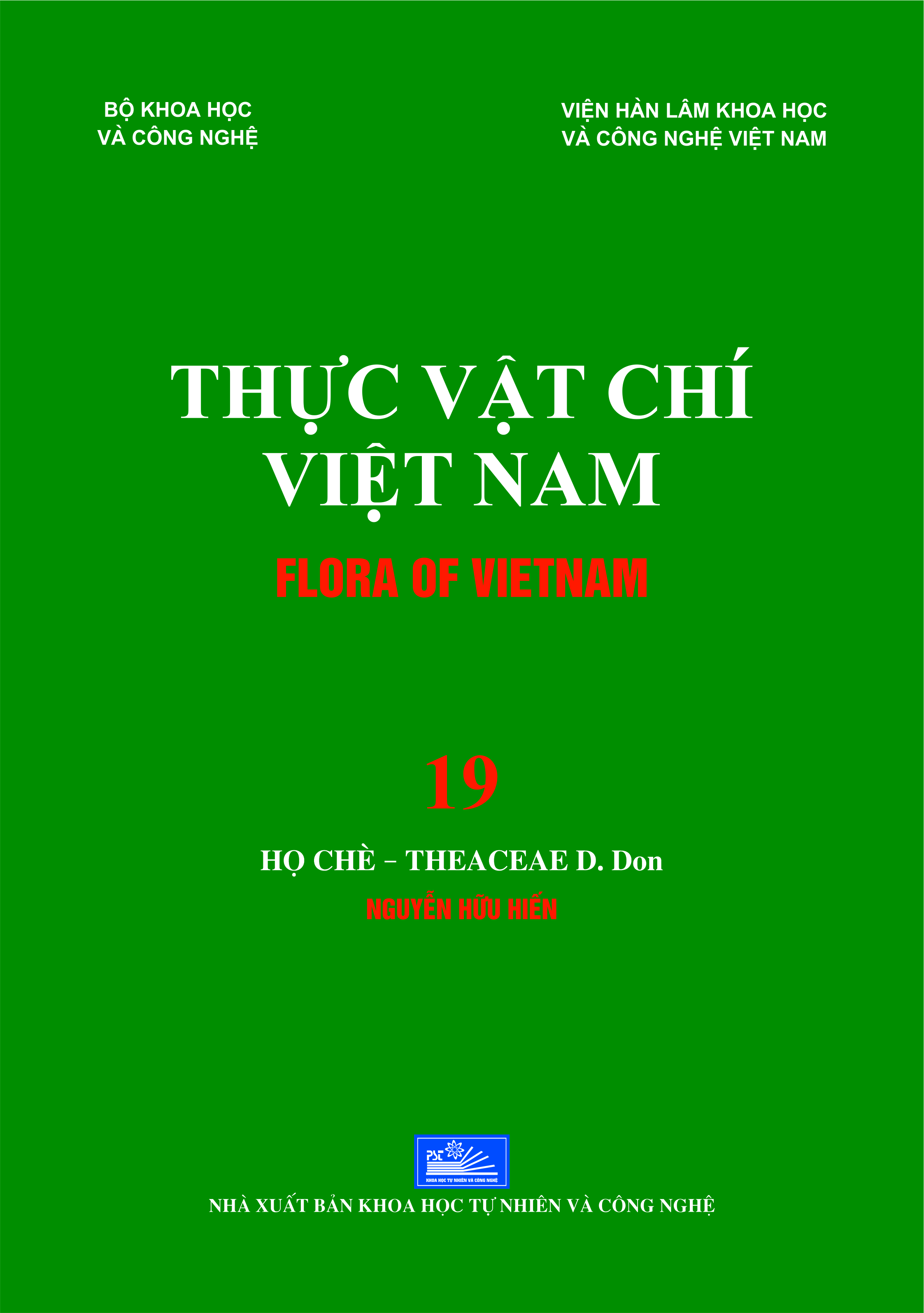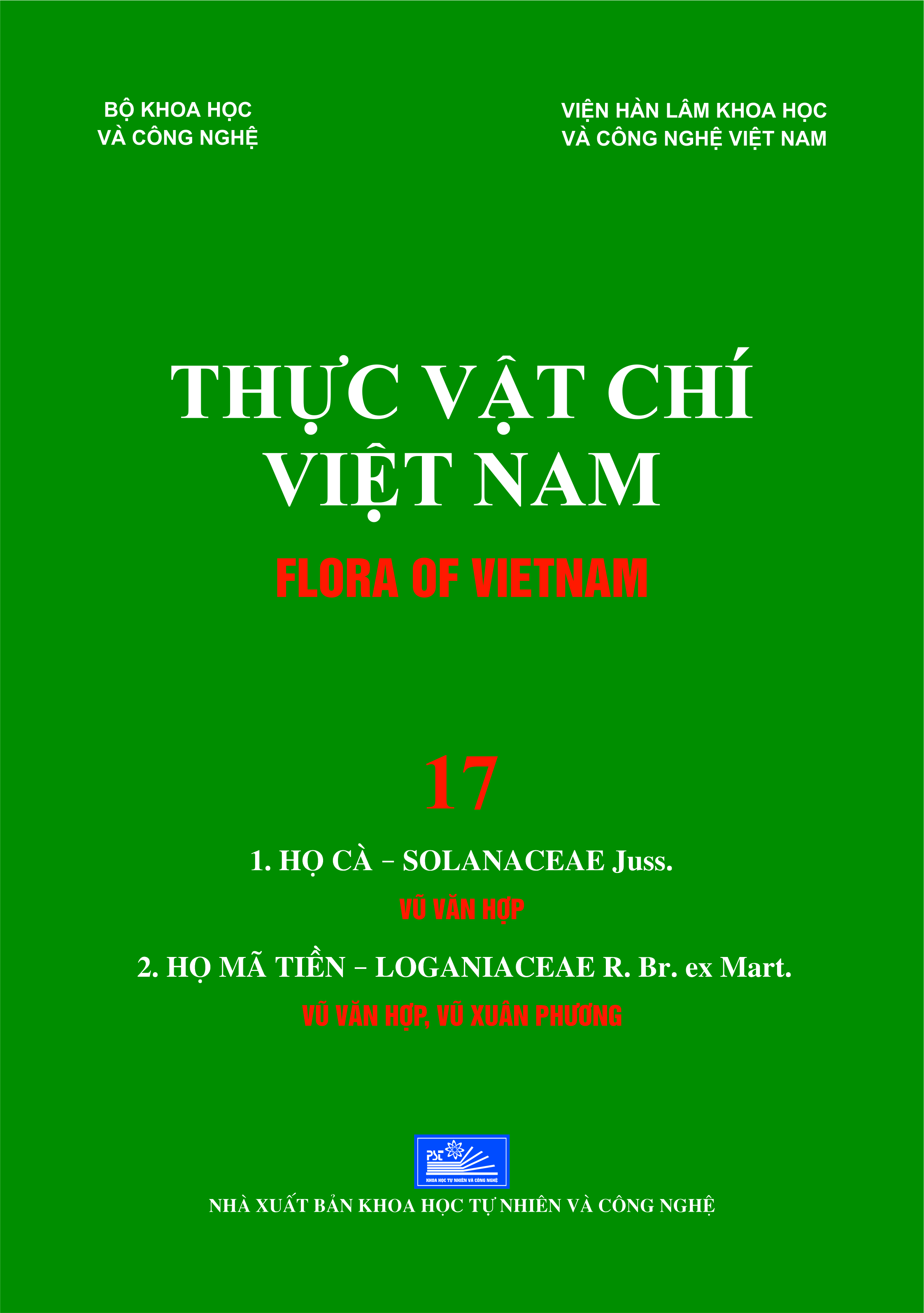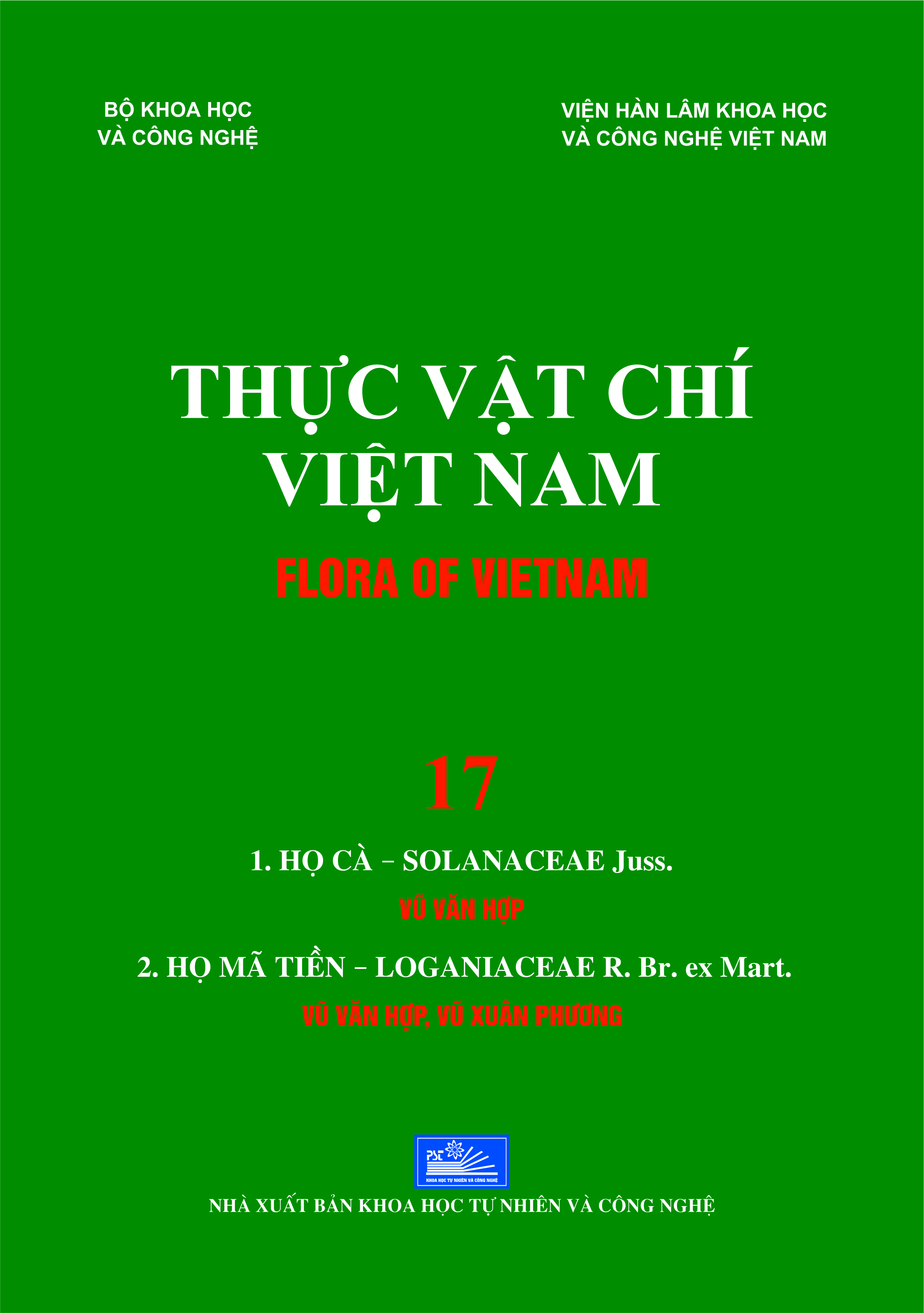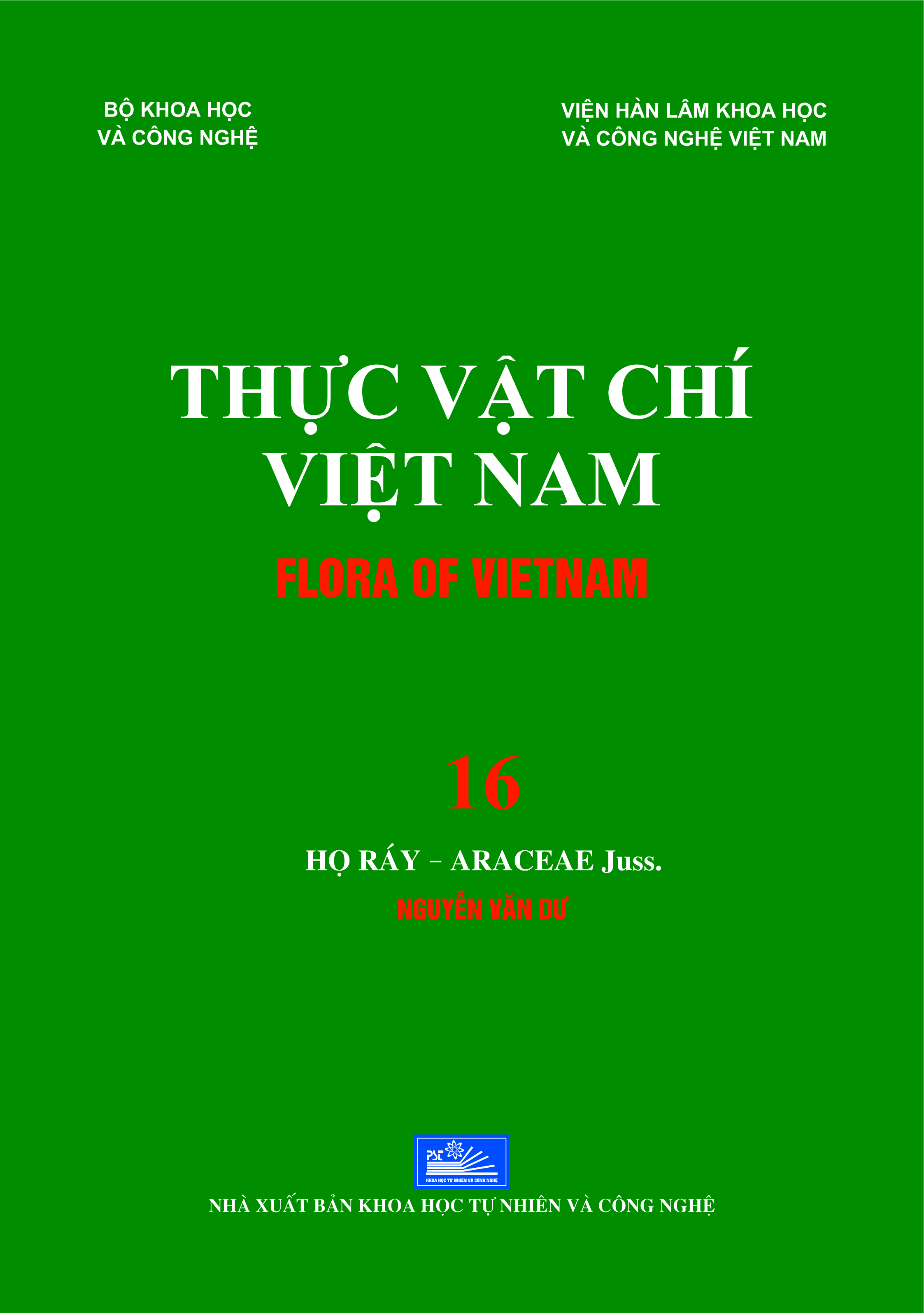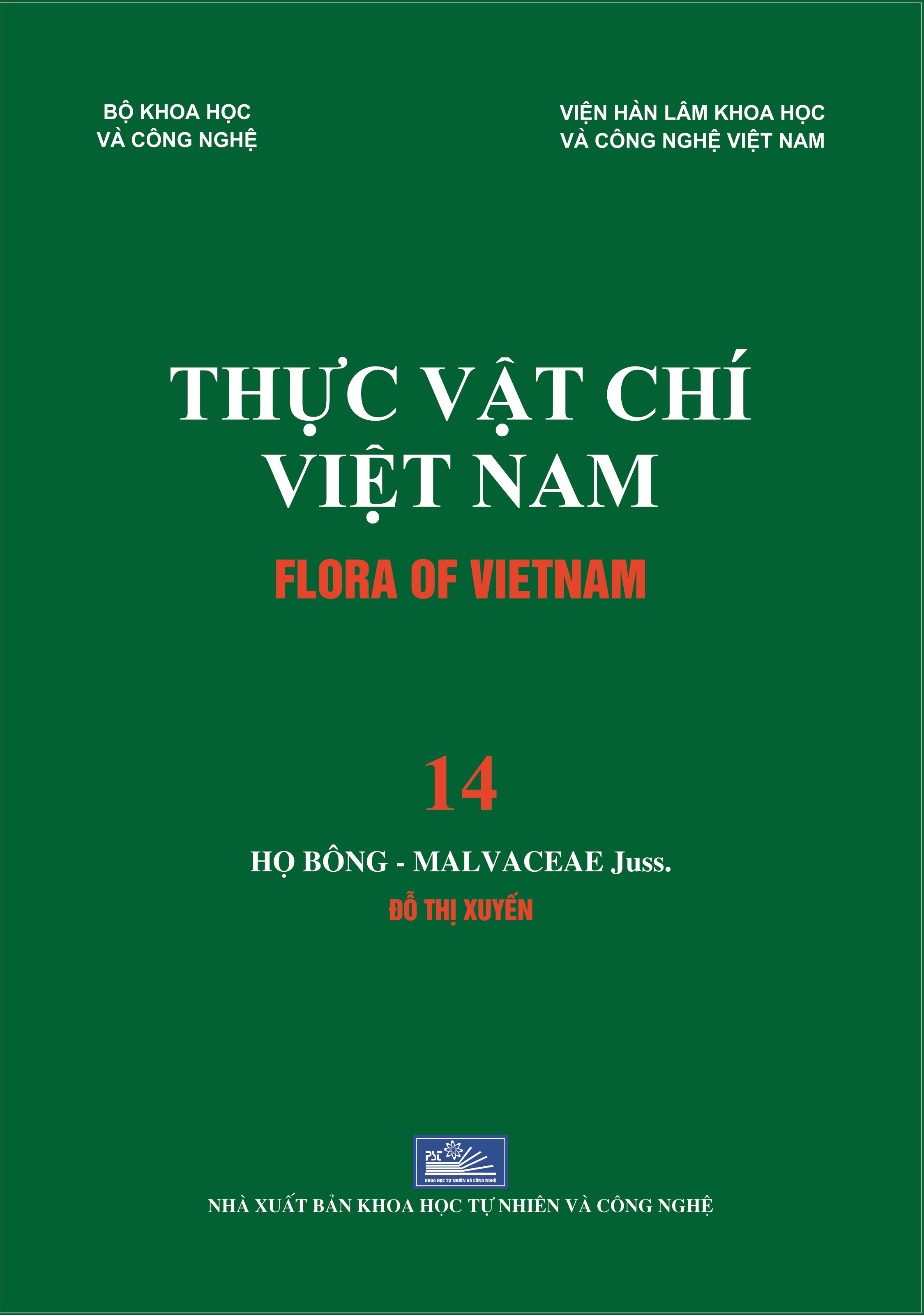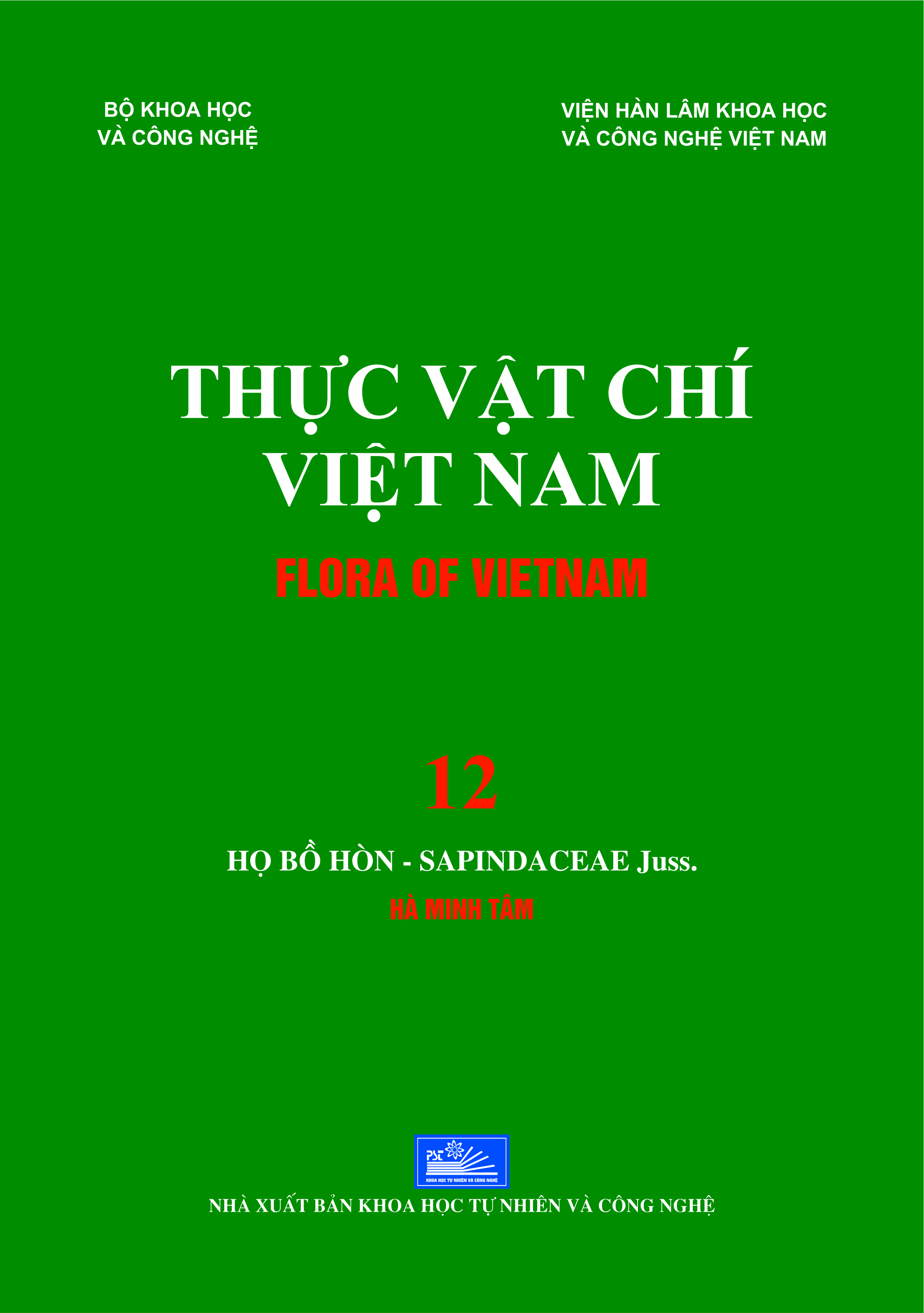ABSTRACT
FLORA OF VIETNAM 14
MALVACEAE Juss.
(4 tribes, 18 genera, 62 species, 1 subspecies and 5 varieties)
INTRODUCTION
The family Malvaceae Juss. comprises of 111 genera and 1800 species which are distributed in the tropical, subtropical to temperate zones of the world. Vietnam has 18 genera, 62 species, 1 subspecies and 5 varieties, which are distributed in all parts of the country. Malvaceae is a very important family possessing many economically important species.
The taxonomy of Malvaceae has been worked out by many famous authors such as C. Linnaeus (1753), A. J. Cavalillé (1785), F. C. Medik (1878), A. J. Jussieu (1789), A. P. de Candole (1824), H. L. Edlin (1935), A. P. Fryxell (1975, 1988), A. Takhtajan (1987), Thorne (2000), S. R. Hinsley (2002-2004), C. Bayer & K. Kubizki (2003), etc.
In Indochina and Vietnam, various authors researched Malvaceae such as J. Loureiro (1790), F. Gagnepain (1910, 1945), Le Kha Ke (1971), Pham Hoang Ho (1970, 1991, 1999), Tran Dinh Ly (1984), Nguyen Tien Ban (1997), Nguyen Tien Ban & Do Thi Xuyen (2003), Do Thi Xuyen (2005, 2006). On the other hand, several Vietnamese authors also worked on different uses of Malvaceae in the country such as Vo Van Chi (1997, 2012), Do Tat Loi (2000), Do Huy Bich et al. (2004), etc.
Some of the notable Malvaceae workers in the adjacent countries of Vietnam are M. T. Masters (India) (1875), W. J. van Borss (Malaysia) (1966-1967), C. A. Backer & R. C. Backuizen (Indonesia) (1965), K. M. Feng (China) (1984), C. E. Chang (Taiwan) (1993), etc.
The present work i.e. Flora of Vietnam __ Volume 14 __ Malvaceae Juss. deals with the taxonomy of Malvaceae in Vietnam. The information presented here are collected during years of research, investigation, collection of specimens in all the regions of Vietnam. Moreover, herbarium specimens kept in herbaria of different institute such as Institute of Ecology and Biological Resources, Hanoi, Vietnam (HN); Institute of Tropical Biology, Ho Chi Minh City, Vietnam (HM); Forest Inventory and Planning Institute, Hanoi, Vietnam (HNF); Hanoi Pharmacy Institute, Hanoi, Vietnam (HNPI); National Institute of Medicinal Materials, Hanoi, Vietnam (HNPM); Hanoi National University, Hanoi, Vietnam (HNU); Pumat National Park, Nghean, Vietnam (HPNP), Kunming Botanical Institute, Academia Sinica, Kunming, Yunnan, China (KUN); Guangxi Institute of Botany, Guangxi, China (KIB), etc.
This book comprised of 316 pages, including introdution on the morphology of Malvaceae in Vietnam, taxonomy publications, different system of classification followed by Vietnamese taxonomists, keys to genera and species, subspecies or varieties. For each taxon both Latin and Vietnamese names have been provided along with description, synonyms, morphology, types, ecological notes and habitat, distribution in Vietnam and the other countries, specimens examined, uses, notes (wherever necessary). In addition, 82 line drawings, 61 pictures, index of Latin and Vietnamese names referances etc. are given.
References, figures and photos from other sources have also been used and properly acknowledged in this study. Takhtajan's system of classification (1987) has been followed.
I. CHECKLIST OF THE TAXA IN FAMILY
MALVACEAE Juss. IN VIETNAM
(4 trib., 18 gen., 62 sp., 1 subsp., 5 var.)
Trib. 1. MALVEAE (2 gen., 3 sp.)
1. ALCEA L. (1 sp.)
1.1. Alcea rosea L. (fig. 20, photo 9)
2. MALVA L. (2 sp.)
2.1. Malva crispa (L.) L. (fig. 21, photo 10)
2.2. Malva sylvestris L. (fig. 22, photo 11)
Trib. 2. ABUTILEAE A. Gray (5 gen., 15 sp., 2 var.)
3. MALVASTRUM A. Gray (1 sp.)
3.1. Malvastrum coromandelianum (L.) Garcke (fig. 23, photo 12)
4. ABUTILON Mill. (2 sp.)
4.1. Abutilon indicum (L.) Sweet (fig. 24, photo 13)
4.2. Abutilon crispum (L.) Medik. (fig. 25)
5. WISSADULA Medik. (1 sp.)
5.1. Wissadula periplocifolia (L.) Presl. ex Thwaites (fig. 26)
6. SIDA L. (9 sp., 2 var.)
6.1. Sida mysorensis Wight & Arn. (fig. 27, photo 14)
6.2. Sida cordata (Burm. f.) W. J. V. Borss. (fig. 28, photo 15)
6.3. Sida javensis Cav. (fig. 29)
6.4. Sida acuta Burm. f. (fig. 30, photo 16)
6.5. Sida parvifolia DC. (fig. 31, photo 17)
6.6. Sida rhombifolia L. (fig. 32, photo 18)
6.6a. Sida rhombifolia var. microphylla (Cav.) Mast. (photo 19)
6.6b. Sida rhombifolia var. retusa (L.) Mast. (photo 20)
6.7. Sida szechuensis Matsuda (fig. 33, photo 21)
6.8. Sida cordifolia L. (fig. 34, photo 22)
6.9. Sida subcordata Span. (fig. 35, photo 23)
7. KYDIA Roxb. (2 sp.)
7.1. Kydia calycina Roxb. (fig. 36, photo 24)
7.2. Kydia glabrescens Mast. (fig. 37, photo 25)
Trib. 3. URENEAE Benth. & Hook. f. (4 gen., 6 sp., 1 var.)
8. MALACHRA L. (1 sp.)
8.1. Malachra capitata (L.) L. (fig. 38)
9. PAVONIA Cav. (2 sp.)
9.1. Pavonia repanda (Roxb.) Spreng. (fig. 39, photo 26)
9.2. Pavonia rigida (Wall. ex. Mast.) Hochr. (fig. 40)
10. URENA L. (2 sp.)
10.1. Urena lobata L. (fig. 41, photo 27)
10.2. Urena sinuata L. (fig. 42, photo 28)
11. MALVAVISCUS Fabr. (1 sp., 1 var.)
11.1. Malvaviscus arboreus Cav. (fig. 43, photo 29)
11.1a. Malvaviscus arboreus var. penduliflorus (DC.) Schery (fig. 44, photo 30)
Trib. 4. HIBISCEAE Endl. (7 gen., 38 sp., 1 subsp., 2 var.)
12. ABELMOSCHUS Medik. (5 sp., 1 subsp.)
12.1. Abelmoschus manihot (L.) Medik. (fig. 45: 1-2)
12.1a. Abelmoschus manihot ssp. tetraphyllus var. pungens (Roxb.) Hochr.
(fig. 45: 3-5, photo 31)
12.2. Abelmoschus crinitus Wall. (fig. 46, photo 32)
12.3. Abelmoschus esculentus (L.) Moench, (fig. 47, photo 33)
12.4. Abelmoschus moschatus Medik. (fig. 48, photo 34)
12.5. Abelmoschus sagittifolius (Kurz) Merr. (fig. 49, photo 35)
13. HIBISCUS L. (19 sp., 1 var.)
13.1. Hibiscus schizopentalus (Dyer) Hook. f. (fig. 50, photo 36)
13.2. Hibiscus grewiaefolius Hassk. (fig. 51, photo 37)
13.3. Hibiscus mutabilis L. (fig. 52, photo 38)
13.3a. H. mutabilis var. roseo-plenus Makino
13.4. Hibiscus syriacus L. (fig. 53, photo 39)
13.5. Hibiscus indicus (Burm. f.) Hochr. (fig. 54)
13.6. Hibiscus rosa-sinensis L. (fig. 55, photo 40)
13.7. Hibiscus mesnyi Pierre ex Laness. (fig. 56, photo 41)
13.8. Hibiscus gagnepainii W. J. V. Borss. (fig. 57, photo 42)
13.9. Hibiscus fragrans Roxb. (fig. 58)
13.10. Hibiscus poilanei Gagnep. (fig. 59, photo 43)
13.11. Hibiscus trichonychius Gagnep. (fig. 60)
13.12. Hibiscus congestifloroides Ban (fig. 61, photo 44)
13.13. Hibiscus asperifolioides Ban (fig. 62)
13.14. Hibiscus surattensis L. (fig. 63, photo 45)
13.15. Hibiscus hispidissimus Griffith (fig. 64)
13.16. Hibiscus acetosella Welw. ex Fic. (fig. 65, photo 46)
13.17. Hibiscus sabdariffa L. (fig. 66, photo 47)
13.18. Hibiscus vitifolius L. (fig. 67)
13.19. Hibiscus cannabinus L. (fig. 68, photo 48)
14. TALIPARITI Fryxell (3 sp.)
14.1. Talipariti tiliaceus (L.) Fryxell (fig. 69, photo 49)
14.2. Talipariti macrophyllus (Roxb. ex Hornem.) Fryxell (fig. 70, photo 50)
14.3. Talipariti simile (Blume) Fryxell (fig. 71, photo 51)
15. DECASCHISTIA Wight & Arn. (3 sp.)
15.1. Decaschistia intermedia Craib (fig. 72, photo 52)
15.2. Decaschistia parviflora Kurz (fig. 73, photo 53)
15.3. Decaschistia crotonifolia Wight & Arn. (fig. 74, photo 54)
16. CENOCENTRUM Gagnep. (1 sp.)
16.1. Cenocentrum tonkinense Gagnep. (fig. 75, photo 55)
17. GOSSYPIUM L. (5 sp.)
17.1. Gossypium herbaceum L. (fig. 76, photo 56)
17.2. Gossypium arboreum L. (fig. 77)
17.3. Gossypium hirsutum L. (fig. 78, photo 57)
17.4. Gossypium barbadense L. (fig. 79, photo 58)
17.5. Gossypium acuminatum Roxb. ex G. Don (fig. 80, photo 59)
18. THESPESIA Soland. ex Corr. (2 sp., 1 var.)
18.1. Thespesia lampas (Cav.) Dalz. & Gibs. (fig. 81, photo 60)
18.1a. Thespesia lampas var. longisepala W. J. V. Borss.
18.2. Thespesia populnea (L.) Soland. ex Correa (fig. 82, photo 61)
II. KEY TO THE GENERA OF MALVACEAE Juss. IN VIETNAM
| 1A. |
Schizocarp or fresh fruit; schizocarp at maturity breaking up into mericarps. Ovary syncarpous. Branches style as many as or twice of carpels. |
|
| 2A. |
Filaments projecting from the whole surface of the column or only the apex, which part without revealed petal. Branches style as many as carpels. Staminal column without teeth. |
|
| 3A. |
Stigma line or oblong. Carpels always over 10. |
(Trib. 1. Malveae) |
| 4A. |
Epicalyx cupule, segments 6-8 lobed. Petal obovate, apex round. Carpels 25 or more. Fruit’s axis dish. |
1. ALCEA |
| 4B. |
Epicalyx segments 3, free. Petal obcordate or obtriangule, apex undulate. Carpels 10-18. Fruit’s axis pillar. |
2. MALVA |
| 3B. |
Stigma head. Carpels always under 10, rarely over 10. |
(Trib. 2. Abutileae) |
| 5A. |
Mericarps with 3 awns. Fruit’s axis dish. |
3. MALVASTRUM |
| 5B. |
Mericarps with 2 awns, rarely without. Fruit’s axis pillar or without. |
|
| 6A. |
Herb, subshrub or shrub. Flower bisexual. Without epicalyx. |
|
| 7A. |
Ovules 2-3(4) per cell. |
|
| 8A. |
Filament connected into one stament column. Carpels 10 or more. |
4. ABUTILON |
| 8B. |
Filament connected into one stament column at the base and 5 bundle upper. Carpels 5. |
5. WISSADULA |
| 7B. |
Ovules only 1 per cell. |
6. SIDA |
| 6B. |
Tree. Flower unisexual. With epicalyx |
7. KYDIA |
| 2B. |
Filaments projecting from the apex of the column, which part ussually revealed petal. Branches style as twice carpels. Staminal column at apex 5 - toothed. |
(Trib. 3. Ureneae) |
| 9A. |
Inflorescens head. With bracts. Without epicalyx. |
8. MALACHRA |
| 9B. |
Flower solitary axillary, rarely raceme, panicule or like-head terminal. Without bracts. With epicalyx. |
|
| 10A. |
Herb or subshrub. Epicalyx 5, Calyx free. Petal expand when anthesis. Schizocarp hairy. |
|
| 11A. |
Fruit hairy but without glochidia. Flower solitary axillary or like-head terminal. Stament column glabrous. |
9. PAVONIA |
| 11B. |
Fruit with long strong glochidia. Flower solitary axillary or raceme, panicule terminal. Stament column hairy. |
10. URENA |
| 10B. |
Shrub. Epicalyx 7-12, Calyx campanulate. Petal don’t expand when anthesis. Fresh fruit, glabrous |
11. MALVAVISCUS |
| 1B. |
Capsule fruit, at maturity breaking up into loculicide. Ovary lysicarpous. Branches style as many as carpels. |
(Trib. 4. Hibisceae) |
| 12A. |
Epicalyx 5-15. Seed reniform, some time globose. |
|
| 13A. |
Ovary 5 carpels. Style with 5 branches. Ovules 2-many per carpels. Ovules hemitropous or apotropous. |
|
| 14A. |
Calyx spathaceous, at apex 5 toothed, unequal, splitting on one side during the expansion of the petal, decious. Fruit ovate, ellip, oblong or rhomboidea. Seed glabrous, with vein. |
12. ABELMOSCHUS |
| 14B. |
Calyx cup, at apex 5 lobed, equal, exits. Fruit globose, rarely obovate, cone. Seed hairy, with glandular spot. |
|
| 15A. |
Stipules usually small, under 2.5 cm long and under 1.2 cm wide; leaf without nectaries on the midribs. Fruit capsular, 5-loculed. |
13. HIBISCUS |
| 15B. |
Stipules usually large, over 2.5 cm long and over 1.2 cm wide; leaf with nectaries on the midribs. Fruit capsular with false dissepiment into 10 loculed. |
14. TALIPARITI |
| 13B. |
Ovary 6-10 carpels. Style with 6-10 branches. Only ovule per carpels. Ovules epitropous . |
15. DECASCHISTIA |
| 12B. |
Epicalyx 3-5. Seed ovate, obovate, angle, rarely reniform. |
|
| 16A. |
Epicalyx 4. Ovary 10 carpels. Style with 10 branches. Stigma head. Seed ovate, near reniform, glabrous, with pale spot. |
16. CENOCENTRUM |
| 16B. |
Epicalyx 3 or 5. Ovary 3-5 carpels. Style near entire, with small angle. Stigma cudgel. Seed obovate, with angle, hairy, some time glabrous excepted seed scar. |
|
| 17A. |
Herb or subshrub. Leaf blade palmately 3-5(7) lobed. Epicalyx 3, broad cordata, exist. Ovary and fruit with punctate by black oil-glands. Seed long hairy. |
17. GOSSYPIUM |
| 17B. |
Shrub or small tree. Leaf blade entire or palmately 2-3 lobed. Epicalyx 3-5, small and narrow, lanceolata, mostly caducous. Ovary and fruit without punctate by black oil-glands. Seed short hairy. |
18. THESPESIA |
III. KEY TO THE SPECIES OF MALVACEAE Juss. IN VIETNAM
3.1. KEY TO THE SPECIES OF ALCEA IN VIETNAM
| Epicalyx cupule, segments 6-8 lobed. Petal obovate, apex round. Capels 25 or more. Fruit’s axis dish. |
1. A. rosea |
3.2. KEY TO THE SPECIES OF MALVA IN VIETNAM
| 1A. |
Peduncle (0,1)0,3-0,5 cm long. Flower 1-1,5 cm in diam. Petal white or pale white. |
1. M. crispa |
| 1B. |
Peduncle 2-3,5 cm long. Flower 5-6 cm in diam. Petal violet or pink with dark violet line. |
2. M. sylvestri |
3.3. KEY TO THE SPECIES OF MALMASTRUM IN VIETNAM
| Mericarps with 3 awns. Fruit's axis dish. |
1. M. coromandelianum |
3.4. KEY TO THE SPECIES OF ABUTILON IN VIETNAM
| 1A. |
Erect shrub. Ovary globose acute apex, carpels 15-20. Mericarp with acute awn as spinose. |
1. A. indicum |
| 1B. |
Slender subshrub. Ovary globose, carpels 10-14. Mericarp without awn. |
2. A. crispum |
3.5. KEY TO THE SPECIES OF WISSADULA IN VIETNAM
| Filament connected into one stament column et the base and 5 bundle upper. Carpels 5 |
1. W. periplocifolia |
3.6. KEY TO THE SPECIES OF SIDA IN VIETNAM
| 1A. |
Leaves palminerved. Mericarps without prominent reticulate venation, thin wall, without split apex. |
1. A. indicum |
| 2A. |
Herb, procumbens and erect or subshrub. Inflorescens panicule axillary or terminal. |
1. S. mysorensis |
| 2B. |
Prostrate herb, slender. Flower solitary or 2-3 racemes axillary or terminal. |
|
| 3A. |
Leaves entire. Mericarps near without awns. |
2. S. cordata |
| 3B. |
Leaves 2-3 lobed. Mericarps with awns. |
3. S. javensis |
| 1B. |
Leaves penninerved. Mericarps with prominent reticulate venation, thick wall, with split apex. |
|
| 4A. |
Stipules of each pair different, one linear to lanceolata, the other linear to filiform, mostly shorter. Stem sparsely hairy, soon glabrescent. |
4. S. acuta |
| 4B. |
Stipules of each pair not different. Stem more or less densely stellate-hairy. |
|
| 5A. |
Style with 5 branches. Carpels 5. |
5. S. parvifolia |
| 5B. |
Style with 7-9(10) branches. Carpels 7-9(10). |
|
| 6A. |
Mericarps with short awns (usually under 0.1 cm long), adaxial glabrous. |
|
| 7A. |
Leaves blade glabrous or sparsely stellate-hairy. Sepal hairy inside surface. Stament column glabrous. |
6. S. rhombifolia |
| 8A. |
Leaves 1,0-2,0 × 0,5-1,0 cm. |
6a. S. rhombifolia var. microphylla |
| 8B. |
Leaves 2,0-3,0 × 1,5-2,0 cm. |
6b. S. rhombifolia var. retusa |
| 7B. |
Leaves blade densely stellate-hairy, especially under surface. Sepal glabrous except margine. Stament column hairy. |
7. S. szechuensis |
| 6B. |
Mericarps with long awns (usually over 0.2 cm long), adaxial hairy. |
|
| 9A. |
Leaves blade upper surface stellate-hairy. Sepal inside surface hairy. Flower 1-1.5 cm in diam. Mericarps 0.2-0.3 cm long. |
8. S. cordifolia |
| 9B. |
Leaves blade upper surface glabrous. Sepal inside surface glabrous. Flower 2.0-2.5 cm in diam. Mericarps 0.4-0.5 cm long. |
9. S. subcordata |
3.7. KEY TO THE SPECIES OF KYDIA IN VIETNAM
| 1A. |
Leaves blade under surface densely stellate-hairy. Fruit with ellip wing, wing 1-1.2 cm long, densely yellow stellate-hairy. Staminal column hairy. |
1. K. calycina |
| 1B. |
Leaves blade under surface glabrous. Fruit with oblong-obovate wing, wing 1.5-2.0 cm long, glabrous or only one round hairy at the base. Staminal column glabrous. |
2. K. glabrescens
|
3.8. KEY TO THE SPECIES OF MALACHRA IN VIETNAM
| Inflorescens head. With bracts. Without epicalyxl |
1. M. capitata |
3.9. KEY TO THE SPECIES OF PAVONIA IN VIETNAM
| 1A. |
Leaves cordata or round cordata, round apex. Flower many in inflorescens. Petal 1.8-2 cm long. Fruit globose. |
1. P. repanda |
| 1B. |
Leaves ovate, acute apex. Flower few in inflorescens. Petal 2-3 cm long. Fruit ellip |
2. U. sinuata |
3.10. KEY TO THE SPECIES OF URENA IN VIETNAM
| 1A. |
Leaf blade entire or palmately 3-5 shallowly lobed. Epicalyx cupular, appressed to the mericarps. Calyx lanceolata, 0.4-0.6 cm long. |
1. U. lobata |
| 1B. |
Leaf blade palmately 3-5 deep lobed and often doubly incised. Epicalyx shallorly cupular or near free, often expand from the mericarps. Calyx oblong-lanceolata or oblong-ellip, 0.3-0.4 cm long. |
2. P. rigida |
3.11. KEY TO THE SPECIES OF MALVAVISCUS IN VIETNAM
| 1A. |
Epicalyx 0.4-0.5 × 0.1-0.2 cm. Stament column 3.5-4.5 cm long. Style 4.5-5.5 cm long. |
1. M. arboreus |
| 1B. |
Epicalyx 1.5-2 × 0.3-0.4 cm. Stament column 5-8 cm long. Style 6-9 cm long. |
1a. M. arboreus var. penduliflorus |
3.12. KEY TO THE SPECIES OF ABELMOSCHUS IN VIETNAM
| 1A. |
Epicalyx 4-5, broad ovate, ca. 0.4-1 cm width. |
1. A. manihot |
| 1B. |
Whole plant white soft sparsely stellate-tomentosa or near glabrous |
1. A. manihot ssp. manihot |
| 2B. |
Whole plant yellow hard densely stellate-hairy or prickly hairy. |
1a. A. manihot ssp. tetraphyllus var. pungens |
| 1B. |
Epicalyx 6-20, line, filiform or lanceolata, ca. 0.1-0.3 cm width. |
|
| 3A. |
Epicalyx (10)12-20, ca. 0.1 cm width. Fruit near globose, ca. 2-3 cm in diam. |
2. A. crinitus |
| 3B. |
Epicalyx 6-10, ca. 0.2-0.3 cm width. Fruit rhomboidea, oblong, rarely globose, ca. 4-25 cm long. |
|
| 4A. |
Peduncle 1-2 cm long, 3-5 cm long in fruit. Stem short hard sparsely hairy, soon glabrous. Fruit oblong, ca. 10-25 cm long. |
3. A. esculentus |
| 4B. |
Peduncle 3-5(7) cm long, 7-20 cm long in fruit. Stem long hard denselly hairy. Fruit ovate, ellip, rarelly near globose, ca. 4-8 cm long. |
|
| 5A. |
Stem 1-3.5 m tall. Without turgid tap-root. Flower yellow, with brown or dark-violet at the base of adaxial surface. Fruit ovate or ellip, ca. 5-8 cm long. Seed glabrous. |
4. A. moschatus |
| 5B. |
Stem 0.3-0.7 m tall. With turgid tap-root. Flower red, pink, rarelly pale yellow, with white, red or pink at the base of adaxial surface. Fruit near globose, ca. 3-4 cm long. Seed hairy in seed scar. |
5. A. sagittifolius |
3.13. KEY TO THE SPECIES OF HIBISCUS IN VIETNAM
| 1A. |
Shrubs or tree |
|
| 2A. |
Sepal long tubular, with 5 teeth. Petal doubly pennilobed to parted, with narrow segments, curved outside. |
1. H. schizopentalus |
| 2B. |
Sepal cup, or cupular, with 5 lobed. Petal entire or shallow incrision, without curved outside. |
1a. A. manihot ssp. tetraphyllus var. pungens |
| 3A. |
Epicalyx free |
|
| 4A. |
Staminal column shorter petal. |
|
| 5A. |
Epicalyx 8-12. |
|
| 6A. |
Fruit obovate, glabrous. Leaves blade not cordata, entire, glabrous. Flower yellow, without exchanged colour. |
2. H. grewiaefolius |
| 6B. |
Fruit globose, hairy. Leaves blade cordata, Leaf blade palmately 5(7,9) lobed, yellow powder glandular hairy in upper surface, denselly hairy in under surface. Flower white or pink, with exchanged colour. |
3. H. mutabilis
3a. H. mutabilis var. rosea-plenus
|
| 5B. |
Epicalyx 5-7 |
|
| 7A. |
Epicalyx narrow line. Leaves blade ellip or ovate, entire, with big unequal teeth in margin. |
4. H. syriacus |
| 7B. |
Epicalyx ovate or ellip with acute apex. Leaves blade cordata or near round ovate, 3(5,7) lobed, with small equal teeth in margin. |
5. H. indicus |
| 4B. |
Staminal column longer petal. |
6. H. rosa-sinensis |
| 3B. |
Epicalyx less or more connected at the base. |
|
| 8A. |
Stem or young branches powder glandular hairy. Epicalyx cup, entire or teeth. |
|
| 9A. |
Epicalyx 5 small teeth. Petal without peltate-hairy. |
7. H. mesnyi |
| 9B. |
Epicalyx near entire or 8-11 teeth. Petal with peltate-hairy. |
8. H. gagnepainii |
| 8B. |
Stem or young branches without powder glandular hairy. Epicalyx cupular or shallowly cupular, segment lobed. |
|
| 10A. |
Flower bud globose. Peduncle with powder glandular hairy, without stellate-hairy or peltate. |
9. H. fragrans |
| 10B. |
Flower bud ovate with acute apex. Peduncle without powder glandular hairy, with stellate-hairy or peltate. |
|
| 11A. |
Epicalyx and sepal with stellate-hairy outter surface. Epicalyx filiform. Stem denselly stellate-hairy. Subshrub. |
10. H. poilanei |
| 11B. |
Epicalyx and sepal without stellate-hairy outter surface. Epicalyx not filiform. Stem hard hairy, peltate or glabrous. Shrub or tree. |
|
| 12A. |
Flower solitary axillary. |
11. H. trichonychius |
| 12B. |
Flower solitary or racemes terminal. |
|
| 13A. |
Pedical 0.5-1.5 cm long or shorter, hard. Leaves blade ovate, glabrous, entire. |
12. H. congestifloroides |
| 13B. |
Pedical 2 cm long or more, slender. Leaves blade cordata, hard hairy, 3-5 lobed. |
13. H. asperifolioides |
| 1B. |
Annual or perennial herbs, erect or procumbens. |
|
| 14A. |
Epicalyx 2 lobed. Procumben herbs. |
|
| 15A. |
Stypules usually auriculate. |
14. H. surattensis |
| 15B. |
Stypules line or lanceolata. |
|
| 16A. |
Peduncles 3-6(10) cm long. Stem, pedicel, peduncle hard denselly spinosa. Whole plant green. |
15. H. hispidissimus |
| 16B. |
Peduncles 0.5-1 cm long. Stem, pedicel, peduncle with soft sparselly spinosa or not. Whole plant reddish. |
16. H. acetosella |
| 14B. |
Epicalyx entire. Erect herb. |
|
| 17A. |
Stem smooth. Leaves blade entire or 3,5(7) shallowly lobed. Epicalyx and sepal fleshy after flowering, without spinosa. Lobed sepal lanceolata without acute apex. |
|
| 18A. |
Epicalyx and sepal succulent, connect at base. Leaf multiform, upper leaf entire, ovate; under leaf with 3,5(7) segment, segment elliptic-oblong. |
17. H. sabdariffa |
| 18B. |
Epicalyx and sepal never succulent, not connect at base. Leaf with 3-5 shallow segments, segment triangle. |
18. H. vitifolius |
| 17B. |
Stem sparselly spinosa. Leaves blade (3)5,7 deeply lobed. Epicalyx and sepal never fleshy after flowering, spinosa. Lobed sepal triangula with long acute apex |
19. H. cannabinus |
3.14. KEY TO THE SPECIES OF TALIPARITI IN VIETNAM
| 1A. |
Leaf with nectaries on the midribs only at the base. |
1. T. tiliaceus |
| 1B. |
Leaf with nectaries scatter on the midribs |
|
| 2A. |
Stem with long yellowish hair, ca. 5-8 mm long; stipules ca. 3-11 × 1.5-3 cm; fruit obovoid, apex with beak. |
2. T. macrophyllus |
| 2B. |
Stem with short pink tomentose, ca. 1-1.5 mm long; stipules ca. 5-7 × 1.5-2.5 cm; fruit ovoid, apex without beak. |
3. T. simile |
3.15. KEY TO THE SPECIES OF DECASCHISTIA IN VIETNAM
| 1A. |
Leaf blade line or oblong, glabrous, prominently reticulate on the upper surface, margin revolute. Flowers red. |
1. D. intermedia |
| 1B. |
Leaf blade ellip, rarely line, hairy, not prominently reticulate on the upper surface, not margin revolute. Flowers pink, white or yellow. |
|
| 2A. |
Upper surface of leaf blade scattered minute stellate hairy. Stipules filiform, entire. Flowers pink or white. |
2. D. parviflora |
| 2B. |
Upper surface of leaf blade densely stellate hairy. Stipules 2-3 deep lobed in each side. Flowers yellow. |
3. D. crotonifolia |
3.16. KEY TO THE SPECIES OF CENOCENTRUM IN VIETNAM
| Epicalyx 4. Ovary 10 carpels. Style with 10 branches. Stigma head. Seed ovate, near reniform, glabrous, with pale spot. |
1. C. tonkinense |
3.17. KEY TO THE SPECIES OF GOSSYPIUM IN VIETNAM
| 1A. |
Epicalyx connate at base, margin entire or 3-7 dentatus, teeth length equal of 1.5-2 times of width. Margin calyx entire or undulation. |
|
| 2A. |
Annual herbs. Leaf blade palmately 5 lobed (rarely 3 or 7 lobed), lobes broad ovate. Epicalyx with margin entire or 3-5 obtuse dentatus. Fruit ovoid with beaked. Seed gluey white woolly. |
1. G. herbaceum |
| 2B. |
Subshrubs or shrubs. Leaf blade palmately 3 lobed (rarely 5 lobed), lobes lanceolata. Epicalyx with margin 5-7 acuminate dentatus. Fruit cone narrow toward apex. Seed unconnected white woolly. |
2. G. arboreum |
| 1B. |
Epicalyx free at base, margin 7-15 dentatus, teeth length 3-4 times of width. Calyx with 5 shallow lobed. |
|
| 3A. |
Leaf blade palmately 3 lobed, lobes triangular, near round or broad ovate. Epicalyx with margin 7-10 dentatus. Staminal tube 1-2 cm long. Fruit near globose. Seed gluey white woolly. |
3. G. hirsutum |
| 3B. |
Leaf blade palmately 3-5(7) lobed, lobes ovate, oblong or ellips. Epicalyx with margin 10-15 dentatus. Staminal tube 3-4 cm long. Fruit oblong-ovate. Seed unconnected white woolly. |
|
| 4A. |
Petal yellow, purple at the base of adaxial surface. Fruit 3-5 cm long. Seed unconnected, with one line yellow hair along the seed. |
4. G. barbadense |
| 4B. |
Petal yellowish; dark yellow, dark red or black at the base of adaxial surface. Fruit 5-7 cm long. Seed connected, with one line yellow hair along half of the seed. |
5. G. acuminatum |
3.18. KEY TO THE SPECIES OF THESPESIA IN VIETNAM
| 1A. |
Peduncles 2.0-3.5 cm long. Sepal cupule, 5 lobed, lobe lanceolata, acute apex. Fruit ellipsoid. Seed 0.3-0.5 cm long, smooth.
Fruit ovate-oblong
|
1. T. lampas
1a. T. lampas var. longisepala
|
| 1B. |
Peduncles 5-7 cm long. Sepal cup, margin entire or undulation. Fruit globose or pyriform. Seed 0.6-0.9 cm long, brown hairy, veined or spot. |
2. T. populnea |
